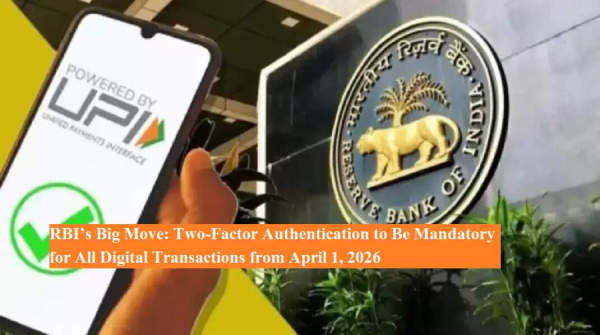
The Reserve Bank of India (RBI) has announced a major step to enhance the safety of digital payments. Starting April 1, 2026, all online and digital transactions in India will require Two-Factor Authentication (2FA) — a move aimed at strengthening protection against online fraud and cyber theft.
Currently, most digital transactions rely on SMS-based One-Time Passwords (OTPs) for verification. However, with the growing risk of phishing, SIM swapping, and identity theft, the RBI has decided to introduce a second layer of security to make digital payments safer and more reliable.
Under the new rule, every digital payment—whether through UPI, debit/credit cards, net banking, or online wallets—will need two separate authentication steps.
After entering the OTP, users will have to confirm their identity using one of the following methods:
Biometric verification: Fingerprint or facial recognition scan through the phone’s biometric system.
Password or PIN: A secure password created by the user and known only to them.
Authenticator app or token: A software-based token (such as Google Authenticator or Microsoft Authenticator) that generates a unique, time-sensitive passcode every few seconds.
This means that even if someone gets access to your SIM card or OTP, they won’t be able to complete the transaction without the second authentication factor.
According to cybersecurity experts, Two-Factor Authentication significantly reduces the risk of online fraud, phishing scams, and unauthorized access.
Digital payment volumes in India have skyrocketed over the past few years, with UPI alone handling over 14 billion transactions per month. While this reflects India’s strong digital adoption, it has also made users vulnerable to sophisticated scams.
By introducing 2FA, the RBI aims to ensure that every transaction is verified not just by device or SMS but also by the physical or cognitive presence of the user.
An RBI spokesperson stated that the decision is part of the regulator’s broader effort to make India’s digital payment ecosystem “safer, transparent, and globally trusted.”
The implementation of 2FA will bring multiple benefits for digital users:
🔒 Higher Security: Even if your phone or SIM is compromised, your bank account remains protected.
👆 Fraud Prevention: Biometric and app-based verification make it nearly impossible for hackers to access your funds.
💡 User Confidence: With safer systems in place, more people will feel comfortable using digital payment platforms.
🕵️♂️ Reduced Phishing Risks: Eliminating sole reliance on SMS-based OTPs will prevent fraudsters from misusing stolen OTPs.
Before the new system goes live, banks and payment service providers will notify customers about the changes and guide them through the setup process.
Here’s what users should do in advance:
Link Aadhaar and biometrics with your bank account for easy authentication.
Install a trusted authenticator app (like Google Authenticator) if you prefer app-based codes.
Update your mobile number and email ID with your bank to ensure smooth transaction alerts.
Stay alert for phishing messages pretending to offer 2FA activation. Always verify communications directly from your bank’s official website or app.
The RBI’s Two-Factor Authentication policy is not just about security—it’s about building long-term trust in India’s booming digital economy.
With the country moving rapidly toward a cashless society, ensuring that every transaction is safe, verified, and traceable has become critical. This move aligns India with global digital security standards, practiced by leading economies like the U.S., U.K., and Singapore.
From April 1, 2026, users will no longer rely solely on OTPs; they’ll verify transactions through biometrics, passwords, or authenticator apps—making digital payments smarter, safer, and more secure than ever before.
In short: RBI’s new Two-Factor Authentication rule marks a new era for India’s digital payments—one where security and convenience go hand in hand. Users should prepare now to embrace this advanced, fraud-proof payment system.